
* While the USSR was fond of building two-seat conversion trainer versions of combat aircraft, the Soviets never actually produced a purpose-built jet trainer -- though the Yakovlev organization did develop a jet trainer designated the "Yak-30" that didn't go beyond prototype stage. After the fall of the Soviet Union, the successor Russian state did perform a competition between two Russian-designed jet trainers, the Mikoyan "MiG-AT" and the Yakovlev "Yak-130", with the Yak-130 selected for production. Alenia, now Leonardo, of Italy also went into production with a Westernized version of the Yak-130, the "M-346".
This document provides a history and description of the Yak-30, the MiG-AT, the Yak-130 / M-346 -- and as footnotes, the Russian "SR-10" intermediate trainer, as well as the Polish PZL "Iskra" and "Iryda" trainers.
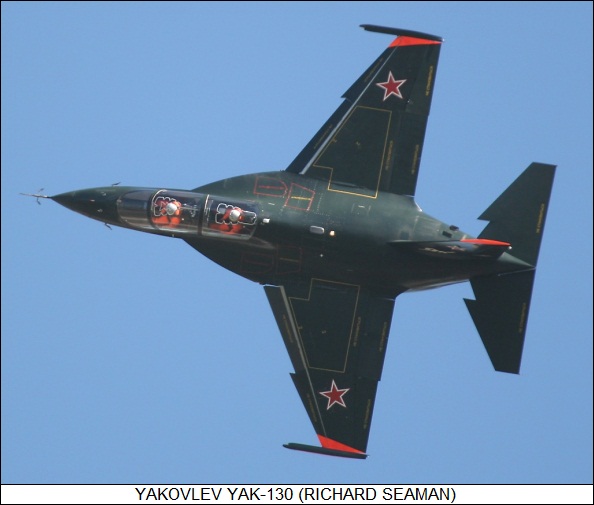
* In 1959, Soviet state authorities issued a requirement for a tandem-seat jet trainer. After examination of proposals, prototype development was authorized for three finalists: the Polish PZL TS-11 Iskra, the Czech Aero Vodochody L-29 Delfin, and the Yakovlev "Yak-30".
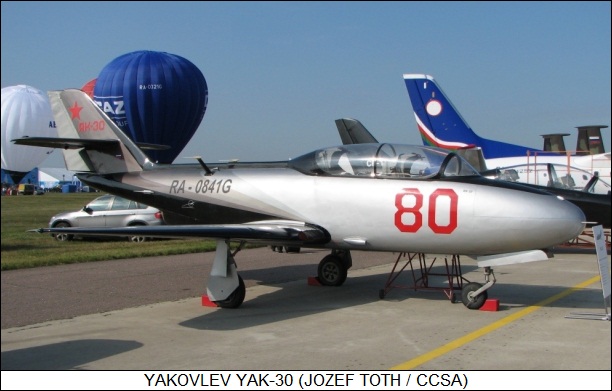
The Iskra is described later, while the Delfin is described elsewhere. The Soviet finalist, the Yak-30, was a tandem-seat jet-powered aircraft with a low-mounted straight wing and tricycle landing gear. It was powered by a Tumanskiy RU-19 axial flow turbojet, with a thrust of 8.83 kN (900 kgp / 1,985 lbf); the engine was designed specifically for the Yak-30. The engine was fed by small inlets in the wing root, with an exhaust under the tail. All the landing gear assemblies had single wheels, the nose gear retracting forward and the main gear hinging in the wings toward the fuselage. The one-piece canopy slid backwards to open; the instructor in the rear could fire both ejection seats, though the cadet in the front could only fire his or her own.
_______________________________________________________________
YAKOVLEV YAK-30:
_______________________________________________________________
wingspan:
9.38 meters (30 feet 9 inches)
wing area:
14.3 sq_meters (153.7 sq_feet)
length:
10.14 meters (33 feet 3 inches)
height:
3.4 meters (11 feet 1 inch)
empty weight:
1,555 kilograms (3,428 pounds)
max take-off weight:
2,550 kilograms (4,960 pounds)
maximum speed:
660 KPH (410 MPH / 355 KT)
service ceiling:
11,500 meters (37,730 feet)
range:
965 kilometers (600 MI / 520 NMI)
_______________________________________________________________
Four Yak-30 prototypes and a nonflying static-test airframe were built. The Iskra was eliminated from the contest early on, with the Poles going on to build it for their own use. The Yak-30 had somewhat better performance overall than the L-29, but the Yak machine was hobbled by a higher level of defects, and so the L-29 was selected instead in August 1961. At least one Yak-30 survives today and, surprisingly, has been restored to flight condition. The RU-19 engine was put into production as an auxiliary power unit for large aircraft, and so parts were available to get the Yak-30's old engine running.
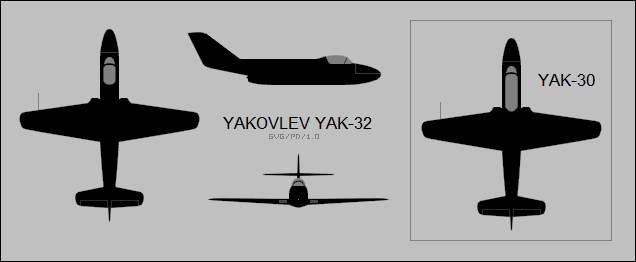
In addition to the Yak-30 machines, the Yakovlev OKB built two prototypes of a single-seat variant, the "Yak-32", as a sports / aerobatic aircraft. The primary customer for the Yak-32 was to be DOSAAF, the Soviet youth flying organization, which prepared youngsters for future careers in aviation. The Yak-32 was also seen as a potential light strike aircraft, with combat-oriented kit and munitions such as gun pods, iron bombs, cluster munitions, unguided rocket launchers, and heat-seeking air-to-air missiles, carried on four underwing pylons. The Yak-32 was canceled along with the Yak-30. One Yak-32 survives as well, also having been refurbished and put back into flightworthy condition.
BACK_TO_TOP* In the early 1990s, the Russian Mikoyan aircraft design organization conducted studies for jet advanced trainer aircraft, with the effort becoming focused on a 1993 VVS (Voyenno Vozdushniye Sily / Red Air Force) requirement for a "lead-in trainer" to bring novice pilots up to speed for handling high-performance combat aircraft, replacing the Czech L-39 Albatros in Russian service. Mikoyan and other Russian design organizations submitted proposals, with the Mikoyan "MiG Advanced Trainer (MiG AT)" and Yakovlev "Yak-130" selected for prototype development.
The first of two MiG AT prototypes performed its initial flight on 21 March 1996, with Mikoyan test pilot Roman P. Taskayev at the controls. A second prototype performed its initial flight on 28 October 1997, this aircraft actually being designated the "MiG ATS" -- the "S" being essentially for "strike", indicating that it was an armed variant for weapons training and daylight combat operations.
As it emerged, the MiG AT was a tidy if conservative design, being a low-wing monoplane made mostly of aircraft aluminum alloy, with a low-mounted straight wing; swept tailfin with a mid-mounted tailplane; twin small turbofan engines, one mounted in a nacelle on each side of the fuselage above the wing; tricycle landing gear; and a tandem-seat cockpit.
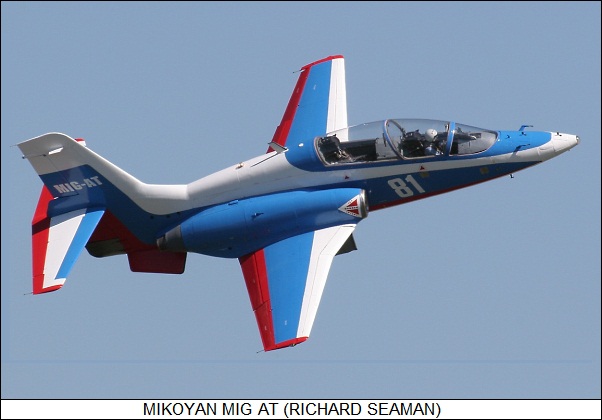
The wing had a nearly straight leading edge outboard, a swept leading edge inboard, and a swept trailing edge. There were drooping leading-edge flaps across the leading edge of each wing, with a double slotted flap and an aileron on the trailing edge. The tail control surface arrangement was conventional, with elevators and rudder, though the rudder was split to deal with the mid-mounted tailplane. There was a prominent fillet in the front of the tailfin, and a split airbrake on the tail at the base of the tailfin. Twin fixed ventral fins were later fitted to the prototypes.
The MiG AT was powered by twin French SNECMA Larzac 04-R20 turbofans with 14.1 kN (1,440 kgp / 3,175 lbf) thrust each, the Russian engine industry not having an appropriate modern powerplant for prototype development. The plan was that the Larzac would be offered for export sales, but MiG AT machines for domestic use were to feature the new Soyuz RD-1700S turbofan, with 16.7 kN (1,700 kgp / 3,750 lbf) thrust, then in development. Initially the engine intakes were set back from the leading edge of the wing, a configuration that suggested possible airflow problems at high angles of attack; that may have been the case, since the intakes were later extended beyond the leading edge of the wing. There were fuel tanks in the center fuselage and the inner wings. All landing gear had single wheels, the nose gear retracting forward, the main gear hinging in the wings in towards the fuselage.
Both aircrew sat on Zvezda K-93 "zero-zero" (zero speed / zero altitude) ejection seats, with the seat for the instructor in the back raised to give a better view forward. The canopy hinged open to the right; there were pull-out steps low on the left fuselage to help the aircrew climb in and out. Avionics were basic -- radios, identification friend or foe (IFF) transponder, navigation and landing aids -- except for a "glass cockpit" with multifunction displays (MFD) and head-up displays (HUD), the prototype configuration apparently being relatively unsophisticated compared to the planned ultimate production configuration. The aircraft's "fly by wire" flight control system was also programmable, allowing the machine to emulate the performance of different classes of aircraft. MiG AT trainers for Russian service were to have Russian avionics, while export machines would have Western avionics.
_______________________________________________________________
MIKOYAN MIG-AT:
_______________________________________________________________
wingspan:
10.16 meters (33 feet 4 inches)
wing area:
17.67 sq_meters (190.2 sq_feet)
length:
12.01 meters (39 feet 5 inches)
height:
4.01 meters (13 feet 2 inches)
empty weight:
3,300 kilograms (7,275 pounds)
max take-off weight:
8,150 kilograms (17,970 pounds)
maximum speed:
850 KPH (530 MPH / 460 KT)
service ceiling:
14,000 meters (45,900 feet)
range (with tanks):
3,000 kilometers (1,860 MI / 1,620 NMI)
_______________________________________________________________
The armed MiG ATS was generally identical, except that it had a centerline stores station, two stores stations under each wing, and a wingtip stores station for an air-to-air missile (AAM) -- giving seven stores stations. Total external warload was a respectable 2,000 kilograms (4,400 pounds). The centerline station was primarily for a cannon pod, most specifically a UPK-23-250 pod with a twin-barreled "teeter-totter" GSh-23L 23-millimeter cannon. Wing stores included unguided rocket pods, general-purpose bombs and cluster bombs, 600-liter (158 US gallon) external tanks, and heat-seeking AAMs.
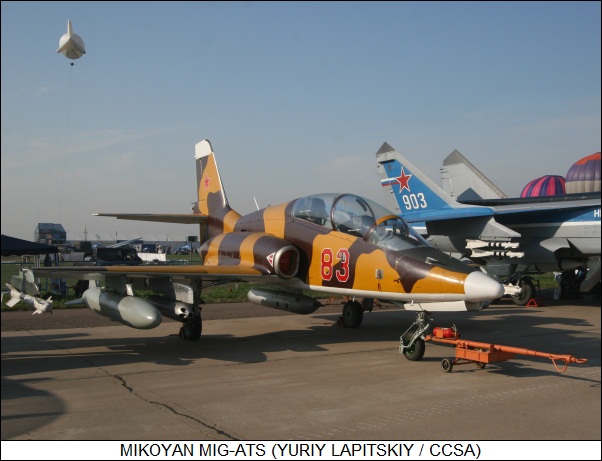
Although the MiG ATS was advertised as capable of carrying smart munitions, avionics for the MiG ATS appears to have had few combat optimizations -- though the nose was rearranged from the MiG AT prototype, the landing light being moved from the nose to the wing, as if to permit fit of a radar if desired. That suggests that smart munitions were simply listed as future possible options for production aircraft. As the aircraft was, laser-guided bombs or missiles could certainly be carried, but they would have to be guided by "buddy designation" from another aircraft or ground forces.
In 2002, the Russian government announced selection of the Yakovlev Yak-130 to fulfill VVS training requirements. While the Mikoyan organization planned more prototypes of the MiG AT, the loss of the award took all the wind out of the program. The Mikoyan organization continued to promote the machine for export sales, proposing variations such as a "MiG AS" single-seat strike fighter with radar, and a "MiG ATSK" shipboard trainer with catapult attachment, arresting hook, stronger landing gear, and folding wings. Nobody bit, and though the two prototypes were used for trials, the program has faded away.
BACK_TO_TOP* The Yakovlev organization decided to take a more innovative approach in the design of their proposal for the Russian trainer competition, the Yak-130, this aircraft having a much less traditional configuration than the MiG AT. The initial prototype, the "Yak-130D" -- "D" for "demonstrator" -- performed its initial flight on 25 April 1996. At that time, Yakovlev was teamed with Alenia Aermacchi of Italy on development of the trainer, but in 1999 the partners agreed to go their separate ways, building their own production derivatives. The Italian derivative, the "M-346", ended up being so similar to the Yak-130 that it is hard to tell the two apart, but the M-346 is very different at the detail level; it is discussed later.
Following selection of the Yak-130 by the VVS in 2002, the first of four pre-production machines performed its initial flight on 30 April 2004. The VVS went back and forth on acquiring the type, but finally ordered 55 of the trainers in late 2011, with the first machines delivered a year later, the last to be delivered in 2015. NATO assigned the Yak-130 the unusually cutesy reporting name of "Mitten".
* As it emerged, the Yak-130 was a thoroughly modern military aircraft in appearance; it was built of aluminum aircraft alloy and composite materials. It had a high-mounted wing with leading-edge sweep and a straight trailing edge, a conventional tail arrangement, a turbofan in a fairing underneath each wing root, and tricycle landing gear.
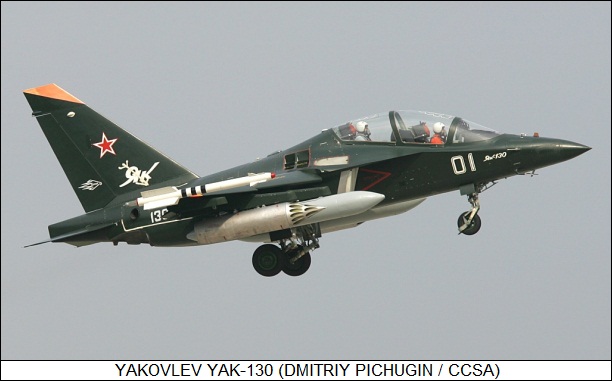
The Yak-130's wings each featured a dogtooth, a leading-edge root extensions (LERX), full-span leading-edge drooping flaps, plus a Fowler (extensible) flap and an aileron on the trailing edge. The tailplanes, like the wing, had leading-edge sweep and a straight trailing edge, along with a particularly prominent dogtooth; the tailplanes were all-moving. The swept tailfin was positioned forward relative to the tailplanes. There was a pop-up airbrake on the spine of the aircraft.
The powerplants for Yak-130s in Russian service were the Ivchenko AI-222-25 turbofan engine, with a thrust of 24.5 kN (2,500 kgp / 5,510 lbf) each. There was a large auxiliary intake on top of the LERX for use in take-offs, landings, and taxiing, the main inlets being closed by doors under such circumstances to reduce the threat of foreign object ingestion. An auxiliary power unit (APU) turbine was fitted in the rear fuselage, marked by a prominent exhaust on the right side. There was a fuel tank in each wing and a fuel tank in the center fuselage. The aircraft could be fitted with a fixed inflight refueling probe on the right side of the nose. Each of the landing gear assemblies had single wheels, the nose gear retracting backward and the main gear tucking up into the fuselage.
The aircrew sat in tandem on Zvezda K-36LT35 zero-zero ejection seats under a one-piece canopy that hinged open to the right; pop-out steps in the left side of the fuselage allowed the crew to climb in and out. The instructor in the back seat sat well higher than the cadet in the front seat, giving an excellent forward view from the rear. The Yak-130 was fitted with a modern glass cockpit, with three MFDs for both aircrew, a HUD and helmet-mounted sight capability for the front-seater, and night-vision goggle (NVG) compatibility. Flight controls were in HOTAS configuration. The aircraft's fly-by-wire system was programmable, to allow it to emulate different types of aircraft. The navigation system included a laser gyro inertial navigation unit with satellite navigation (GPS / GLONASS) backup.
_______________________________________________________________
YAKOVLEV YAK-130:
_______________________________________________________________
wingspan:
9.72 meters (31 feet 10 inches)
wing area:
23.52 sq_meters (253.2 sq_feet)
length:
11.49 meters (37 feet 8 inches)
height:
4.76 meters (15 feet 7 inches)
empty weight:
4,600 kilograms (10,140 pounds)
max take-off weight:
10,290 kilograms (22,685 pounds)
maximum speed:
1,050 KPH (645 MPH / 560 KT)
service ceiling:
12,500 meters (42,650 feet )
range:
2,545 kilometers (1,580 MI / 1,375 NMI)
_______________________________________________________________
Although the Yak-130's armed capability was basically for weapons training, the aircraft was also offered as a useful light multi-role combat aircraft, and is kitted up appropriately. It featured kevlar armor around the cockpit, engines, and avionics compartment. It was fitted with Zhukovskiy Osa (Wasp) multi-mode radar, capable of tracking eight air targets simultaneously and engaging four of them, while tracking two ground targets. Alternative radars could be fitted on customer request, and the aircraft could also carry targeting pods for smart munitions; one was displayed with a nose-mounted laser rangefinder. Defensive countermeasures could include a radar warning receiver, RF jammers, and chaff-flare dispensers.
The Yak-130 had nine stores stations: one under the centerline, three under each wing, and a wingtip station for heat-seeking missiles such as the R-73 (NATO AA-11 Archer) AAM. There was no apparent support for radar-guided AAMs. A 23-millimeter or 30-millimeter cannon pod could be carried on the centerline. Possible ground-attack munitions included dumb bombs and cluster munitions, unguided rocket pods, laser-guided bombs and missiles, and electro-optic guided bombs. Promotional material also mentioned carriage of reconnaissance and jammer pods, but those options were futures, to be qualified on customer requirement. Total external load was a hefty 3,000 kilograms (6,600 pounds).
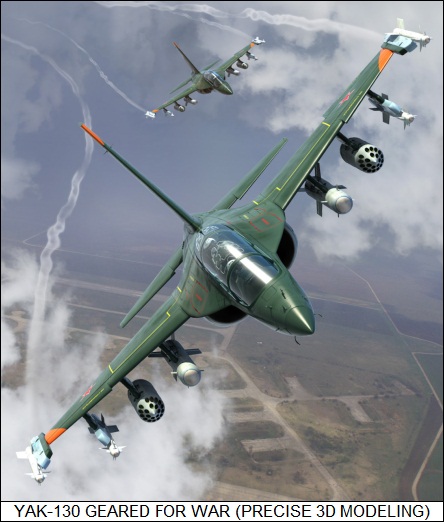
The original Yak-130D started life with a considerably different configuration to the production Yak-130. The biggest difference was that at the outset, the Yak-130D had winglets; they proved too fragile and were deleted. Another difference was that the original wings didn't have dogtooths. The Yak-130D was also fitted with DV-2SM turbofans from PSLM of Slovakia, providing 21.5 kN (2,200 kgp / 4,850 lbf) thrust each. The DV-2 series was based on the Ivchenko AI-25, originally used on the Yakovlev Yak-40 small jetliner, then on the Czech Aero Vodochody L-39 Albatros jet trainer. The DV-2 series was then designed in Czechoslovakia with Russian help, to power improved versions of the L-39. The DV-2SM is on offer as the powerplant for export versions of the Yak-130.
Algeria was the first export buyer, ordering 16 in 2006. Libya ordered a batch, but the deal fell through in the wake of the Libyan Revolution in 2011. Syria ordered 36; Vietnam 8; Belarus 8; Bangladesh 24; and Myanmar 12. There has been consideration of a single-seat attack variant, a naval trainer variant, and even a four-seat variant (somehow!) for crew training or liaison work, but none of these projects have gone anywhere -- and given the difficult situation of the modern Russian state, are not likely to go anywhere for a long time.
BACK_TO_TOP* As noted above, the Yakovlev organization partnered with Alenia Aermacchi of Italy for the initial development of the Yak-130. The two firms went their separate ways, Alenia Aermacchi inheriting the Yak-130D demonstrator, and working to "Westernize" the design as the "M-346 Master". Through some confusing organizational changes, in 2016 Alenia Aermacchi ended up as a component of the Italian Leonardo, previously Finnmeccanica, Group and no longer exists as a distinct organization -- but the M-346 is still described as the "Aermacchi" M-346 in company literature. In any case, the name "Leonardo" is used here for simplicity.
Although the airframe remained largely unchanged from the Yak-130 -- the only giveaway was a finlet mounted between the LERX and the wing on the leading edge, an item not seen in production Yak-130s -- the M-346 was very different at a systems level. It was powered by two Honeywell F124-GA-200 low-bypass turbofans, providing 28.2 kN (2,880 kgp / 6,350 lbf) thrust each, and featuring dual full-authority digital engine controls.
The M-346 featured a Microturbo Rubis APU for starting and ground power, and was fitted with Martin-Baker Mark 16D zero-zero ejection seats. The cockpit was pressurized and climate-conditioned, with the crew sitting under a canopy that hinged open to the right. The trainer also included an "on-board oxygen generation system (OBOGS)", eliminating the need for bottled oxygen. The designers considered using a sidestick controller but finally decided on a center stick configuration, with HOTAS controls.
The M-346 featured a four-channel digital fly-by-wire (FBW) system, developed by Teleavio/Marconi of Italy in cooperation with BAE Systems of Britain. The FBW system not only permitted flight control over a wide envelope of flight conditions, it could also be reprogrammed to accommodate various levels of pilot skill, or to simulate different classes of operational aircraft.
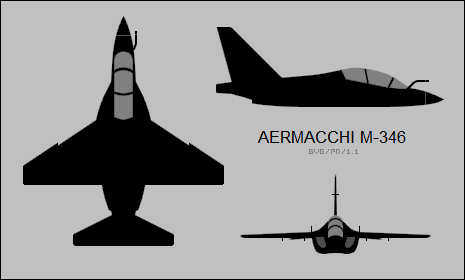
Both the front and back seat cockpit panels had three color MFDs and a HUD, all provided by Galileo Avionica. The controls were compatible with NVGs, with helmet-mounted displays being introduced as well after initial production. The flight instructor could use the display systems for in-flight simulations to train cadets in various types of scenarios, such as air combat or ground attack. The training system scored the cadet on the exercise, and a ground-based debriefing system used data stored by the aircraft during the exercise to allow review of the exercise.
_______________________________________________________________
AERMACCHI M-346:
_______________________________________________________________
wingspan:
9.72 meters (31 feet 11 inches)
wing area:
23.5 sq_meters (253 sq_feet)
length:
11.49 meters (37 feet 8 inches)
height:
4.76 meters (15 feet 7 inches)
empty weight:
4,625 kilograms (10,200 pounds)
MTO weight:
9,500 kilograms (20,950 pounds)
max speed at altitude:
985 KPH (610 MPH / 585 KT)
service ceiling:
13,715 meters (45,000 feet)
range:
1,890 kilometers (1,175 MI / 1,020 NMI)
_______________________________________________________________
The trainer had a comprehensive avionics suite, linked by twin MILSTD-1553B digital data buses and featuring a Honeywell laser-gyro GPS-INS system for long-range navigation. It could be fitted with a centerline stores pylon and a pylon under each wing -- all wet, for carriage of external tanks. Combat stores were not carried by the baseline trainer version. The M-346 could be fitted with a bolt-on inflight refueling probe.
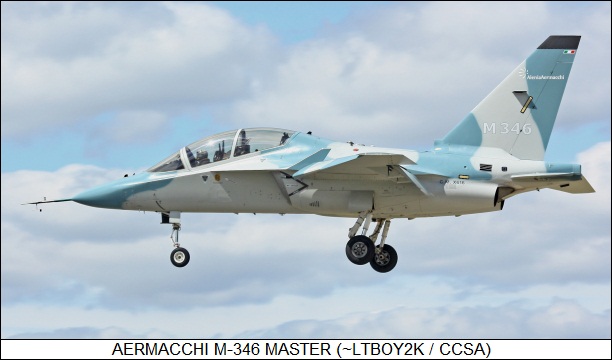
A full-scale mockup of the M-346 was displayed at the Farnborough Air Show in 2002. Initial flight of the first of three prototypes was on 15 July 2004, with Olinto Cecconello at the controls. The second prototype took to the air in 2005. The program went forward without a launch customer for some time, but finally the AMI placed an order for 9 machines, with the first two "T-346A" trainers rolled out in late 2010, being subsequently delivered to the AMI. A second order for 9 machines was placed in 2016, for a total of 18.
Some of the T-346As were flown by an "International Flight Training School" set up as a partnership between Leonardo and the AMI, which offered flight training services for hire to nations that can't afford their own training facilities. The AMI has also evaluated the T-346A for the "dissimilar air combat training" role -- finding it very well suited to "aggressor training" with Italian Typhoon fighters, and boosting the M-346's merits as a combat aircraft in its own right.
The AMI order was followed by export sales:
The M-346 was offered for a US Air Force competition to replace the Northrop T-38 Talon, with the American version of the M-346 being designated "T-100". It was to have a boom refueling socket in the back -- with the dorsal airbrake being relocated -- plus a slightly enlarged cockpit. It was also to have a dashboard / control layout more like that of the Lockheed Martin F-35 Joint Strike Fighter, with a wide-screen flat-panel "large area display (LAD)" to give future F-35 pilots experience with the aircraft they are ultimately going to fly. Such capabilities as the T-100 lacked relative to the F-35 were to be simulated by the avionics system. The competition was run by the Saab-Boeing T-7A Red Hawk, but it did allow Leonardo to evaluate new technologies for the M-346.
In 2016, Leonardo unveiled a prototype of the "M-346FT", meaning "Fighter Trainer", which was intended for munitions training and light daylight strike or reconnaissance, with the original M-346 recast as the "M-346AJT", meaning "Advanced Jet Trainer". The M-346FT had five stores stations instead of three, total stores load being 1,800 kilograms (4,000 pounds). It also had a reinforced airframe, a tactical datalink, radar warning receiver, and chaff-flare dispenser.
In addition, Leonardo has pushed a light strike variant, the "M-346FA", meaning "Fighter Attack", with the M-346FT prototype remodeled as the M-346FA prototype, and revealed to the public in the spring of 2017. The M-346FA built on the M-346FT by adding:
Potential combat stores for both the FT and FA were the same, including guided bombs or unguided up to 225 kilograms (500 pounds) in size; rocket pods; cannon pods; AIM-9 Sidewinder or other AAMs; and a Rafael Litening targeting pod or Reccelite reconnaissance pod. Total external stores load was 2,000 kilograms (4,400 pounds). Given that the FA had a radar, it could potentially support long-range AAMs as well, but there was no mention of such from Leonardo. So far, there's been no interest in the M-346FT or M-346FA.
BACK_TO_TOP* As noted above, while the Yak-30 jet trainer did not enter production -- the Czech L-29 Delfin being selected instead -- the Poles did manufacture their competitive offering, the PZL Mielec TS-11 Iskra (Spark), for their own use. Four Iskra prototypes were built, the initial flight of the first being on 5 February 1960. Type approval was granted in 1961, with initial deliveries of the "TS-11 Iskra Bis-A" in 1963 and introduction to Polish Air Force service in 1964. It would have a long service life, notably being used as a mount for Polish air demonstration teams.
As it emerged, the TS-11 was of clean, if conservative, configuration -- featuring a "pod and boom" arrangement, with the powerplant on the bottom rear of the fuselage and the tail sticking back on a boom above the engine exhaust. The aircraft was made mostly of aluminum alloy and had low-mounted wings with the engine intakes near the wing roots; a conventional tail arrangement; tricycle landing gear; and a tandem-seat cockpit.
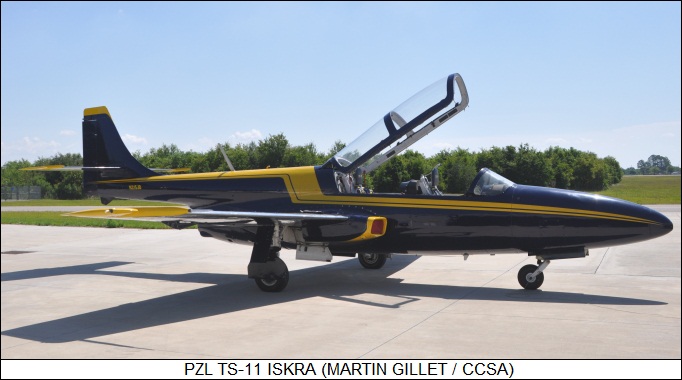
The wings featured double slotted flaps and a small wing fence at midwing. There were "fence"-style airbrakes on the top and the bottom of each wing, just inboard of the fence and forward of the flaps. The wings had modestly swept leading and trailing edges, plus a noticeable dihedral. The tailfin had a swept leading edge; the tailplane was mounted slightly above the fuselage.
The initial prototype was powered by a British Bristol Siddeley Viper Mark 8 turbojet with 7.85 kN (800 kgp / 1,760 lbf) thrust, early production aircraft being powered by a Polish-made copy of this engine, the WSK HO-10. From 1966, Iskras were produced with the Polish-designed WSK SO-1 turbojet featuring 9.8 kN (1,000 kgp / 2,200 lbf) thrust. From 1969, Iskras were built with the SO-3, featuring the same thrust but longer time between overhauls; and then the SO-3W, with thrust uprated to 10.8 kN (1,100 kgp / 2,425 lbf). There was a fuel tank in each inner wing, plus two fuel tanks in the center fuselage, giving a total capacity of 1,200 liters (317 US gallons).
All landing gear assemblies had single wheels, the nose gear retracting forward and the main gear hinging in the wings to retract towards the fuselage. There was a bumper under the tail to protect against tail strikes. The canopy was hinged on the rear to open upward, with the crew sitting on lightweight ejection seats, the rear seat being slightly above the front seat to give the back-seater a (somewhat) better forward view. Flight controls and avionics were entirely conventional; of course, the Iskra had dual controls, as well as blind-flying panels.
_______________________________________________________________
PZL MIELEC TS-11 ISKRA:
_______________________________________________________________
wingspan:
10.07 meters (33 feet)
wing area:
17.5 sq_meters (188.4 sq_feet)
length:
11.25 meters (36 feet 11 inches)
height:
3.25 meters (10 feet 8 inches)
empty weight:
2,460 kilograms (5,425 pounds)
max take-off weight:
3,800 kilograms (8,375 pounds)
maximum speed:
720 KPH (445 MPH / 390 KT)
service ceiling:
12,500 meters (41,000 feet)
range:
1,460 kilometers (905 MI / 785 NMI)
_______________________________________________________________
An armed version, the "Bis-B" was produced, being fitted with a single NS-23 or NR-23 cannon, firing out of a fairing on the right side of the nose. Each wing could be fitted with two stores pylons for a total of four, with a maximum total warload of 400 kilograms (880 pounds). Bombs or unguided rocket pods could be carried -- rocket pods being preferred because rockets could be aimed more or less by registering on the cannon fire. External fuel tanks could also be carried on the inboard pylons; it is unclear if they could be carried on the outer pylons as well. There was also a reconnaissance variant, the "Bis-C", with cameras instead of armament. A prototype of a single-seat attack variant, the "BR-200", was flown in the early 1970s, but it didn't go into production.
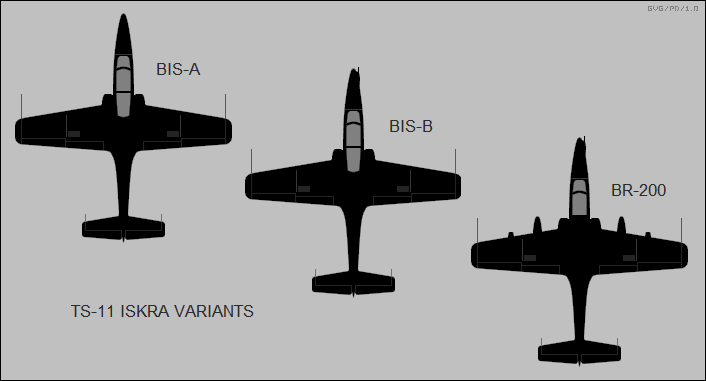
The Indian Air Force (IAF), the Iskra's only foreign buyer for new-build aircraft, obtained 76 examples of a "Bis-D" similar to the Bis-B. The final main production variant was the "Bis-DF", capable of being configured for both the attack and reconnaissance roles. The last Iskra was delivered in 1979, with 424 built. The IAF retired the last of its Iskras in 2004, but at last notice the Poles were still flying them in dwindling numbers, the fleet having received some minor avionics upgrades following the end of the Cold War, it seems for NATO interaction. There was talk of a more serious upgrade to a modern cockpit configuration, but it went nowhere. Used Iskras are now fairly common on the civilian airshow warbird circuit, the aircraft reportedly being sturdy and pleasant to fly.
* In the 1980s, PZL Mielec began work on a more advanced successor to the Iskra, with the initial prototype of the "I-22 Iryda (the Greek Goddess Iris)" performing its first flight on 3 March 1985. The Iryda had pleasing lines, being a near-clone of the Franco-German Dassault-Dornier Alpha Jet trainer, with a high mounted wing featuring leading-edge sweep and a straight trailing edge; a conventional swept tail arrangement; twin turbojet powerplants; tricycle landing gear; and a tandem-seat cockpit.
The Iryda had a length of 13.22 meters (43 feet 4 inches), a wingspan of 9.6 meters (31 feet 6 inches), and an empty weight of 4,560 kilograms (10,055 pounds). The wing had a noticeable anhedral droop, with each wing capable of being fitted with two stores pylons for a total of four. The powerplants were WSK-PZL Rzeszow SO-3W22 turbojets with 10.79 kN (1,100 kgp / 2,425 lbf) thrust each. All landing gear assemblies had single wheels, with the nose gear retracting forward and the main gear tucking sideways into the fuselage. Both aircrew had zero-zero ejection seats, sitting under individual rear-hinged canopies. There was a GSh-23L two-barreled 23-millimeter cannon in a fairing on the belly under the cockpit; total external stores load was about 1,000 kilograms (2,425 pounds).
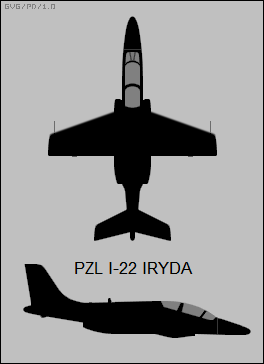
The development history of the Iryda was confused to the point of absurdity, with a wild litter of proposed and prototype configurations that would take a lot of work to sort out with any reliability. It would be hardly worth the bother, since the program fizzled out in the late 1990s. It seems the worst difficulty was inadequate thrust of the SO-3W22 engines, prototypes being flown with various alternative engines such as the Rolls-Royce Viper Mark 535 turbojet, with about 35% more thrust than the SO-3W22. However, having got off on the wrong foot, trying to add fixes and improvements led to cost escalation that bogged down and finally killed the exercise. Whether it was done in by poor management, or circumstances beyond management control is unclear; one might suspect it was some of both.
It appears that about eighteen Irydas were built, with roughly half going into service with the Polish Air Force -- with their distressing lack of engine power leading to withdrawal after a brief term of service. Most of the photos available of the I-22 are of "gate guards" and museum exhibits.
BACK_TO_TOP* As a footnote, China came up with their own variation on the Yak-130, the "Hongdu JL-10". Initial flight was on 13 March 2006.
The JL-10 looked enough like a Yak-130 to be mistaken for it, but it was clearly not a Yak-130 -- the exhaust / tail configuration being obviously different. The dimensions and weights of the two aircraft were similar, but not identical. It was said to have been designed with assistance from the Yak organization, but the JL-10 heavily leverages off Chinese technology, featuring a modern glass cockpit and HOTAS controls. Two variants are on offer:
The aircraft had two stores hardpoints under each wing and wingtip launch rails; it could be fitted with a centerline gun pod. Munitions carriage allowed it to be used for armaments training or in the light attack role. In full production, the JL-10 was to be fitted with Chinese-built WS-17 engines, but it's unclear if that's happened yet.
Production deliveries began in 2017. Some have been obtained by the People's Liberation Army Air Force and Navy. Export versions included:
* As another footnote, the Russian KB SAT organization promoted yet another Russian jet trainer, the "SR-10". After displaying a mockup at the Moscow MAKS airshow in 2009, KB SAT went on to fly a prototype on 25 December 2015.
The SR-10 was of primarily composite construction, with a tandem-seat cockpit, featuring zero-zero ejection seats, and tricycle landing gear, all gear assemblies with single wheels. It had a forward-swept wing with a sweep of 10 degrees, with the prototype powered by an Ivchenko AI-25TL turbofan engine, with generates 16.87 kN (1,720 kgp / 3,790 lbf) thrust. The production aircraft were expected to be fitted with a more modern Russian engine, such as the NPO Saturn AL-55.
Length was 9.59 meters (31 feet 6 inches), height was 3.55 meters (11 feet 8 inches, and wingspan is 8.40 meters (27 feet 7 inches). Cruise speed was 520 KPH (320 MPH / 280 KT), with a service ceiling of 6,000 meters (19,700 feet) and a maximum range of 1,500 kilometers (930 miles / 810 NMI). Maximum take-off weight was 2,700 kilograms (5,950 pounds), while normal take-off weight was 2,400 kilograms (5,290 pounds). The SR-10 was intended for primary and intermediate flight training; it did not have weapons capability. Nobody bought it, and work was given up on the aircraft late in 2018.
* Sources include:
JANE'S ALL THE WORLD'S AIRCRAFT and the online Wikipedia were also consulted for details.
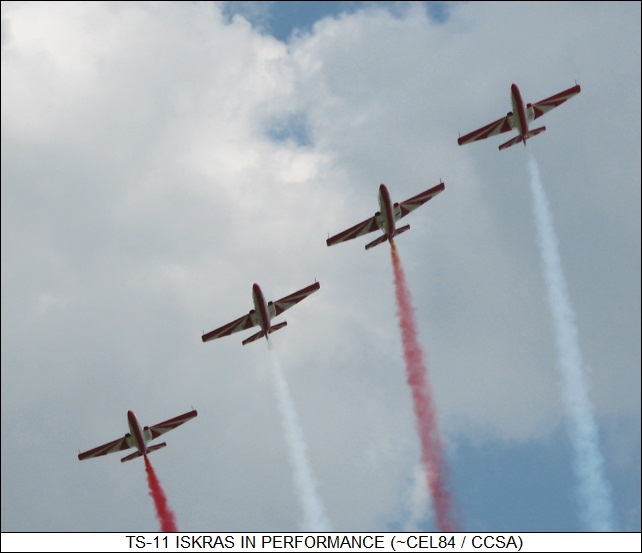
* Revision history:
v1.0.0 / 01 jun 12 v1.0.1 / 01 may 14 / Review & polish. v1.1.0 / 01 apr 16 / Added SR-10. v1.1.1 / 01 mar 18 / Review, polish, & update. v1.2.0 / 01 jun 20 / Added JL-10 comments. v1.3.0 / 01 apr 22 / More on JL-10. v1.3.1 / 01 apr 24 / Review, polish, & update. (+)
The section on the Yak-30/32 was originally part of a document on early Yak jets, while the section on the M-346 was originally part of a document on Aermacchi trainers.
BACK_TO_TOP